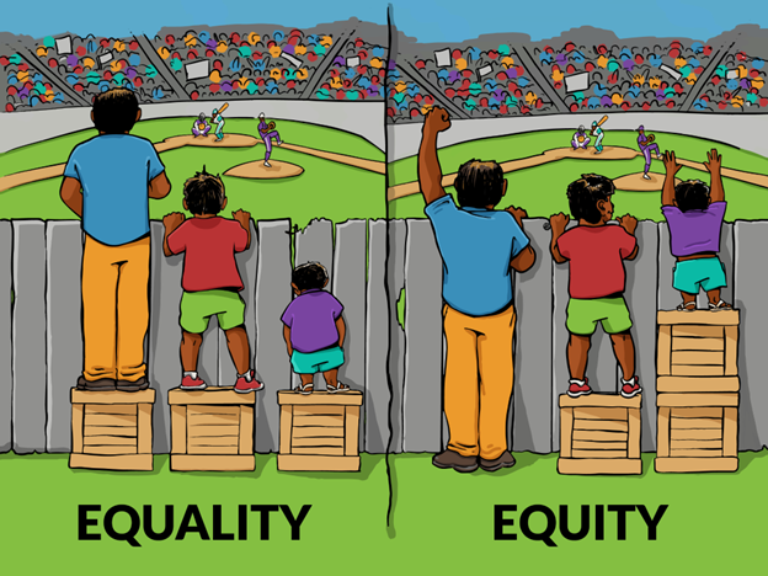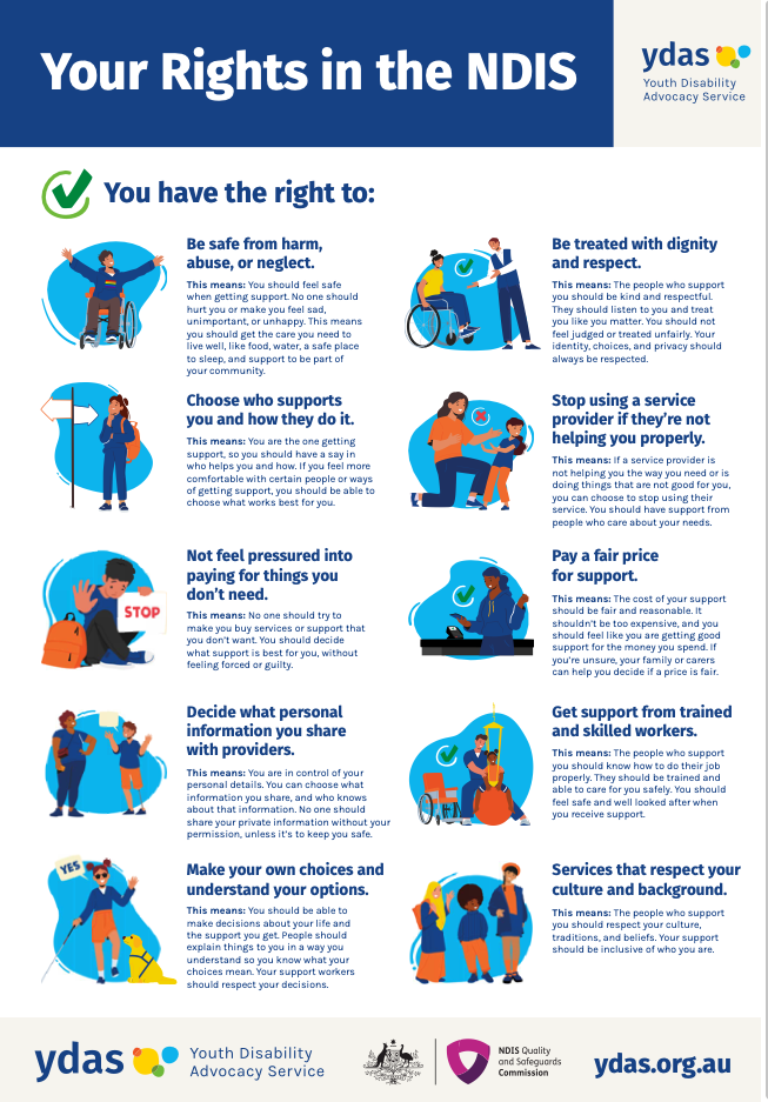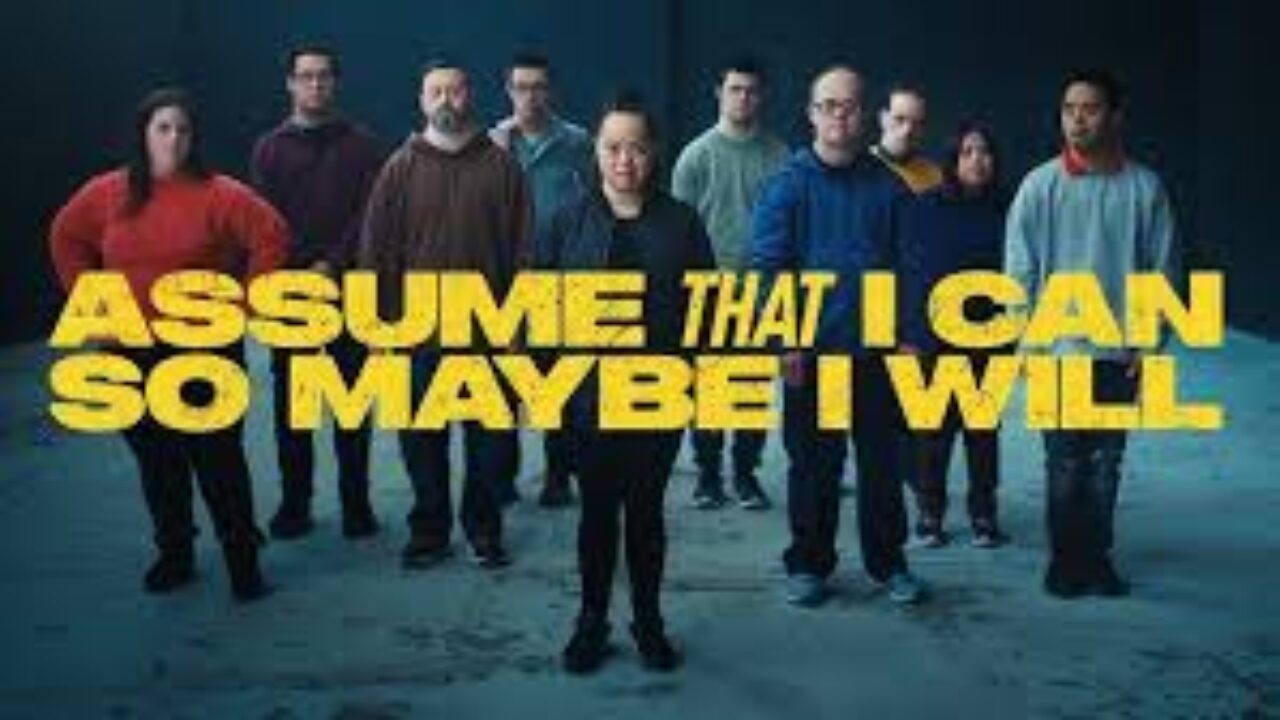Disabled young people's rights
Understanding and upholding the rights of disabled young people
As an NDIS service provider, it is important to understand and protect the rights of disabled young people.
Embedding the rights of disabled young people
You should embed the rights of disabled young people in every part of your service, including:
- Policies and procedures
- Staff training and practices
- How services are developed and delivered
You will learn how your organisation can do this by continuing through this hub.

Equity vs. Equality
Understanding the difference between equality and equity is key to respecting rights. Equality means treating everyone the same, while equity means providing the right support to meet individual needs.
As a service provider, you must create equity for disabled young people. Equity makes sure that disabled young people have real access, choice, and control.
You can learn more about equality and equity on YWCA Spokane’s site.
Relevant rights to be aware of
Disabled young people have series of rights that are relevant when receiving supports. These are in addition to human rights that all people have.
We’ve listed some of them below so you can think about about how your organisation has integrated rights into its policies and practices.
You should also think about what your organisation can do to better uphold the rights below.
Rights
The rights that disabled young people have under the NDIS include:
- The right to live without violence, abuse, exploitation or neglect
- The right to receive dignity and respect from supports
- The right to choose who delivers supports and how they deliver it.
- The right to pay a reasonable rate for supports and services.
- The right to privacy and to decide what information is shared with providers.
- The right to make decisions with informed consent
- The right to receive supports and services that are culturally appropriate and sensitive to the background and needs of the participant (including access to Auslan).
Disabled young people who use your services have the same consumer rights as they would with any other service. These rights are called ‘consumer guarantees’.
It is illegal for a business or organisation to:
- not give refunds
- say they are not responsible for problems with a product or service
- include anything that removes a consumer’s rights in a service agreement.
Consumer rights are automatic and can’t be taken away. When buying a product of paying for a service or support, a person has the right to expect that it:
- is an acceptable quality
- is fit for a particular purpose
- matches the description
- is provided in a reasonable time.
For more information about consumer rights, you can visit the ACCC website: Consumer rights and guarantees | ACCC
Young people are entitled to:
- be safe
- live free from abuse and neglect
- get information about how to raise a safety concern
- expect that adults keep them safe
- be listened to and for action to be taken if there is a safety concern.
The United Nations Convention on the Rights of Persons with Disabilities (UNCRPD) outlines specific human rights for disabled people.
Read more from the Australian Human Rights Commission: UNCRPD Overview
Australia has implemented these rights through key legislation, including:
- The Disability Discrimination Act (1992) – Protects disabled people from discrimination. Learn more about the Act.
- State and Territory Laws – Additional protections exist at state and territory levels.
For more on disability rights in Australia, visit the Attorney-General’s website.
Why This Matters for Service Providers
As an NDIS service provider, you are responsible for making sure your services align with these rights and that disabled people receive equitable, respectful, and safe support. Understanding these laws helps create inclusive and rights-based services.

Rights in the NDIS
We have developed a poster outlining the rights of disabled young people in the NDIS. You can download it below.
Consent
Consent, the right to choice, and the dignity of risk are all connected.
Read on to learn about what they are and how they interact.
Consent changes throughout a person’s lifetime and can depend on their unique context. Everyone should be empowered to make decisions about their own lives. As young people grow from children to adults, their ability to provide informed consent and be involved in decision-making grows and develops.
For example, a young child can make a decision about giving someone a hug. They understand what it means, and if they want to do it or not. However, at that age, they don’t understand what it means to have their image online, and so it is up to a responsible adult to make that decision. The level of risk should determine what level of capacity is needed to give consent.
If you are working with a person under the age of 18, it is best to assume they have the capacity to give consent. You should assess their capacity on a case by case basis. As a general rule, you can assume anyone over the age of 15 can give consent, unless a relevant law says otherwise. Even then, it is always best practice to include the disabled young person in the consent process.
Sometimes, a disabled young person cannot give consent not because they don’t have capacity, but because of barriers such as:
- Others presuming they do not have capacity to consent until they are 18
- Others presuming they don’t have capacity due to characteristics of their disability
- Inaccessible consent and decision-making processes
- Things haven’t been explained to them in a way which they understand
If a person is unable to give consent, it may be appropriate for a parent or guardian to provide it on their behalf.
As a person gets older, you should give them more opportunities to give consent based on their ability to give consent. For example, if you begin working with someone when they are 9 years old, but now they are 15, you should have a meeting with them to discuss what they consent to within your service. This should include information that they are comfortable to share with their parents and others. Remember – Consent is not a one and done action – it is ongoing.
Informed consent can be given when a person is:
- able to understand what their decision is about
- able to understand the potential outcomes of their decision. – the risks and benefits
- able to understand the other options they have
- given without pressure
The person must have the support they need to understand this information. This means they must be given the information in a way that is accessible to them and meets their support needs.
In some states, having this information means that a person can give informed consent. In other states, it can be called informed decision making.
It is best practice to assume that a person can give informed consent when provided information in an accessible manner, unless you have specific information that says otherwise. Assuming a lack of ability to give consent leads to overall negative outcomes.
For more information about consent and young people, visit YERP.
Disabled young people have a right to be included in decision-making when it comes to their own lives, no matter their age. Sometimes, there may be a law or regulation which says that a parent or guardian must provide formal consent, however this doesn’t mean that the disabled young person cannot also be involved in decision-making.
There are lots of tools and guidance available to help disabled young people be involved in decision making. One example is ‘supported decision-making’ and another is known as ‘shared decision-making’. While they sound similar, they are different things which seek to uphold the rights of people to be involved in decisions about their own lives.
Supported decision making involves removing barriers to enable some disabled people to be more involved in providing consent and making decisions.
Shared decision-making involves children & young people making decisions alongside their health professionals. This may involve their parents or guardians in this too. Here is an example from Orygen Youth Health about their shared decision making process.
Capturing young people’s voices is very important. The Student Voice toolkit is created by disabled young people to support secondary school students be involved in decision making.
Benefits of including disabled young people in decision making include:
- Upholding their rights
- Improved engagement and trust
- Improved outcomes
- Developing independence and life skills
Informed consent is a necessary aspect of the right to choice. This right is core to the NDIS, and a major part of the human rights of disabled young people.
The Royal Commission into the Violence, Neglect, Abuse and Exploitation of People with Disability (DRC) found that disabled people are regularly restricted in their ability to have full choice and control over their lives when accessing and receiving disability services.
Disabled people must be at the centre of decision-making about their services for their rights to be realised. They should have choice about daily decision making, such as what to have for dinner and what activities they participate in. These seemingly small choices enables disabled young people to gain the skills and confidence to make bigger choices and live a fulfilling and independent life.
The Right to Choice means that a disabled young person should have the dignity of risk. The NDIS Quality and Safeguard Framework describes ‘dignity of risk’ as ‘supporting people to take informed risks to improve the quality of their lives’.
Every disabled young person should have dignity of risk.
The Royal Commission into the Violence, Abuse and Neglect of People with Disability (DRC) states:
‘Rather than trying to find ways to eliminate all risk – which can be highly restrictive and out of proportion to the level of risk involved – the dignity of risk for NDIS providers means working with participants to define acceptable risk levels in delivering supports to achieve their goals. This must be done in a way that considers the individual circumstances of each participant. It also means supporting participants in positive risk-taking, including recognising when the risk is something the participant can decide on, and negotiation how best to support the wishes of the participant‘ (Volume 10 pg 120).
It is understood that as a whole, service providers are risk adverse. This can often be driven by organisational concerns regarding reputational risk and a ‘complicated deferral to workers‘ occupational health and safety concerns. However, this approach fails to recognise the benefits to empowering their clients to make informed decisions about the level of risk they will take, and how it ultimately reduces the risk of violence, abuse and neglect.
The DRC suggests that when approaching risk, service providers should:
- ensure that risks affecting service users, the organisation and the organisation’s reputation are appropriately ranked
- develop an approach to risk that is preventative and enabling rather than reactive
- develop data collection, analysis and reporting capabilities, and
- regularly evaluate how data is gather and disseminated throughout the organisation.
When balancing duty of care and the dignity of risk, it’s hard to understand where the line is. However, dignity of risk must be realised to support independence and positive outcomes.
Your staff must understand the importance of dignity of risk, and their legal and ethical requirements to support it. Processes and procedures should be developed to empower workers to support the dignity of risk with everyone they work with, but especially with disabled young people.

Assume that I can
Disabled young people have often experience people making assumptions about what they can and can’t do.
Check out this video by CoorDown about the harms these assumptions can have on disabled people.
Privacy
When working with disabled young people, it’s important that all staff understand and respect their obligations under privacy law.
Everyone has the right to privacy under the Privacy Act, however specific confidentiality laws may change from state to state.
Personal information that could identify an individual is considered private. You can read more about this at the Office of the Information Commissioner.
Any personal information collected by your business or organisation must be protected. This information can only be shared or used for the specific reason it was collected, or if consent has been provided (With some exemptions). To read more you can go to the Office of the Information Commissioner.
In general, confidential information may include:
- a disabled young person’s name, address, date of birth, gender identity, sexuality, diagnosis(es)
- things the disabled young person tells you about themselves;
- things other people tell you about the disabled young person (for example, information from doctors reports)
- the fact that a disabled young person was or is a participant with your business or organisation
- any professional judgements or opinions about the disabled young person
- physical information like photographs or drawings of the disabled young person
Your business or organisation’s code of conduct should clearly state how staff are expected to protect the privacy of disabled young people.
For more information on boundaries and privacy, check out this page from YERP.
YERP - Boundaries and PrivacyBalancing privacy and sharing information
Some service providers get confused about balancing the privacy of a disabled young person and sharing information with their parents/carers or child rep/NDIS nominee.
A Child Representative or Nominee of an NDIS Plan can make decisions about how NDIS Plan funding is used, but they are not entitled to know everything a disabled young person shares with their providers.
You should assume that at the age of 15 a disabled young person can consent to information being shared with one of these people.
You should ask for consent before sharing any information.
Remember – consent is not a one and done action. It is ongoing and can change over time.
Human rights and disability awareness training
Having staff do human rights and disability awareness training helps to embed disabled young people’s human rights in your business or organisation.
It also helps to make sure that support workers and staff are aware of their obligations to meet the human rights of disabled young people.